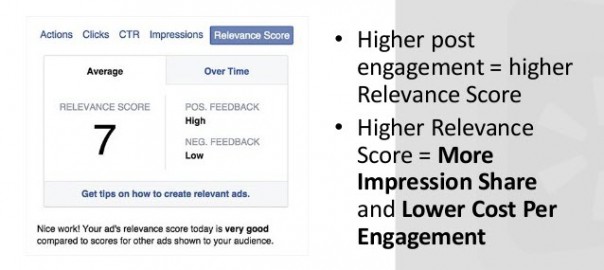It’s never been more important to include paid social media as part of your digital marketing strategy. Between the completely ineffective reach of organic content on Facebook, the ridiculous potential exposure offered by Twitter, and the amount of time prospective customers spend on social media every week, if you’re not advertising on social, you’re seriously missing out!
In today’s post, I’ll be counting down the top 10 paid social media hacks of all time, taken from my recent webinar with Hanapin Marketing’s Matt Umbro. Let’s get started!
Paid Social Media Hack #10: Quality Score in Facebook and Twitter Ads
Quality Score is a familiar metric to AdWords and Bing Ads advertisers, but it’s just as important on Facebook and Twitter.
Facebook’s Relevance Score
On Facebook, Quality Score is known as Relevance Score. Facebook calculates this score based on how engaging your ads are. The more engagement, the better the Relevance Score.

As you can see from the figure above, a high Relevance Score should be one of your primary goals as a Facebook advertiser. Higher Relevance Scores translate to greater impression shares and lower costs-per-engagement, making your ads more visible AND more cost-effective!
Twitter’s Quality Adjusted Bid
On Twitter, Quality Score is calculated according to three major metrics:
- Relevance
- Resonance
- Recency
Relevance is determined by – you guessed it – how relevant your tweets are to the interests of your audience. Resonance is how engaging your tweets are, such as how many favorites, retweets, and replies they generate. Recency refers to the timeliness of your tweets, with more weight given to “fresher” tweets.
So what’s the big deal, and what does this have to do with “quality adjusted bids”? Well, on Twitter, quality adjusted bids are calculated by the three “Rs” above and your bid amount. The big deal is that for every one point increase in engagement, my research estimates that Twitter advertisers see a 5% decrease in cost-per-engagement:

This means that highly relevant ads can cost as little as ONE PENNY PER RETWEET!

Just as you pay close attention to Quality Score in AdWords and Bing Ads, you should be equally focused (if not more so) on Quality Score on Facebook and Twitter!
Paid Social Media Hack #9: Tweet Often, Only Promote Your Best Stuff
Some advertisers are tempted to promote a wide range of social content to “mix it up.” However, all this does is dilute the potential impact of your very best content – which is the only content you should ever pay to promote.
Only promote your very best content. Not the “good” stuff, not even the “great” stuff – the very best. By “best,” I mean the stuff that is performing the best, so not just what you want to perform well, but the content that is already getting a lot of attention and engagement from your audience.
We did this at WordStream with a blog post about the death of Google+, and it blew us away:

We knew this was a hot story, so we paid to promote it on Twitter. We spent a grand total of $ 250 to promote this tweet, which not only netted us 1,500 retweets, but more than 100,000 visitors! Obviously this represents insane ROI, so only promote your very best content – let other handles tweet useless fluff!
How to Find High-Engagement Tweets
The easiest way to identify high-engagement tweets is by exporting data from your Twitter Analytics dashboard.

This allows you to examine the data for engagement metrics such as retweets, favorites, and replies, making it easy to see which tweets are hitting the mark. Those top-performers are the ones you want to amplify.
Paid Social Media Hack #8: Leverage the Power of Keyword Targeting and Hashtags
Firstly, Facebook doesn’t offer keyword targeting options, so this hack doesn’t apply to Facebook advertisers (you have to target specific interests). Twitter, on the other hand, is a goldmine for keyword targeting, but it works very differently on social than it does on Google search.
Let’s take a look at a comparison of keyword targeting on Google vs. Twitter:

Keyword targeting on Google often feels like you’re marketing to robots – I call this “caveman English”. The keywords are rigid, blunt, and direct. Social keywords on Twitter are much more conversational, informational, and use hashtags. This can actually make targeting them feel more “natural,” as you can serve ads to users based on these conversational phrases that don’t feel as salesy as ads on Google. Also, it’s important to note that on Twitter, you’re targeting people who have used certain keywords in their Tweets, in addition to keyword searches on Twitter.
The Ridiculous Power of Hashtags
Hashtags are amazingly powerful to Twitter advertisers. They scream high user engagement, and make it ridiculously easy to target relevant users by topic or interest.
Take this tweet for example. Just by using the hashtag #gameofthrones, this tweet was retweeted almost 800 times! Sure, it might have gotten retweeted a bunch of times if I hadn’t used the hashtag, but there’s no way it would have gotten this much engagement without it.

Think carefully about keyword targeting on social, and don’t overlook the importance of hashtags! This combination can be awesomely powerful and generate incredible results. Note: to do this on Facebook, you would have to target people who were interested in Game of Thrones.
Paid Social Media Hack #7: Increase Commercial Intent Using In-Market Segments
Social media advertising presents amazing opportunities for advertisers due to the enormous size of their audiences, but these platforms lack the kind of commercial intent offered by search ads. So what do we do? We narrow the field to users who are ready to buy by using in-market segments.
Facebook partners with data brokers to provide advertisers with detailed information on purchase histories of its users. This means that marketers can target increasingly granular audiences based on the things they’ve bought, places they’ve gone, and virtually anything else tied to their credit card statements. This allows us to create highly specific audience segments.
This is an example of a segment I use to advertise WordStream’s services on Facebook. In this case, I’m targeting people who’ve bought business marketing software:

This gives me a potential audience of 6.1 million people! You can see how Facebook has partnered with Epsilon to access this kind of purchasing data, as well as a description of the audience segment and the source of the data.
You can do something similar in Twitter, too. They actually use the same audience data as Facebook! Here’s another example, this time for a coffee retailer that’s going after people who’ve bought coffee as part of the behavioral profile data owned by Datalogix accessed by Twitter:

You can target custom audiences as broad or as narrow as you like. Remember, though, that the more specific you get, the smaller the audience is likely to be.
Paid Social Media Hack #6: Demographic Targeting
Similar to custom audiences, you can (and should) be targeting custom audiences based on demographic data.
AdWords advertisers are no strangers to demographic targeting options, but Twitter and Facebook go a little deeper than Google does (for now), offering advertisers the choice to target users based on a whole bunch of different data points. You can target users based on level of education, household size, income, “life events” like getting married or the birth of your first kid, even net worth. In fact, there are over 2,000 of such options in Twitter and Facebook!
This is an example of just a handful of the demographic targeting options Twitter offers:

Segmenting your audiences like this is a great way to make sure your ads are appearing in front of potential customers. Sure, you could carpet-bomb everyone on social media with your ads, but it’s better to be seen by the right people rather than all the people. This will help keep your engagement rates up and your cost per engagement down.
Paid Social Media Hack #5: Social Media Remarketing
Remarketing is absolutely essential for any marketer, but it’s even more important in paid social media campaigns. Given how much time people spend on social media, you’d be crazy not to be tracking visitors to your profiles who didn’t convert right away. However, remarketing on social is an entirely different ballgame than it is on the Google Display Network.
The first major difference is the visibility of remarketing ads. On the Display Network, the majority of remarketing ads are simply never seen:

In fact, viewability of remarketing ads is less than 45% in some verticals. As you can see in the figure below, this is particularly brutal in categories such as Hobbies & Leisure:

One of the biggest reasons for this wide disparity in remarketing ad viewability is page position. For display remarketers, positioning is very important, as not all users will scroll to a part of the page where a remarketing ad is being shown:

For social media remarketers, however, page position becomes irrelevant. There is no position one, position two etc., as people’s timelines just keep scrolling on and on, making positioning far less of an issue – and viewability much higher, which is great news!
Custom Website Audiences in Facebook
If you’re planning a remarketing campaign for Facebook, the way to do this is by using something called Custom Website Audiences. This is where you’ll specify the range of pages in your cookie pool for retargeting purposes.

Tailored Website Audiences in Twitter
Specifying the range of pages you want to include in your retargeting cookie pool is similar on Twitter. To do this, you’ll use Twitter’s Tailored Website Audiences function:

Product Ads on Facebook
One of the coolest things about remarketing on Facebook is the ability to use product ads directly within Facebook. These are a lot like Google’s Shopping ads, and allow you to target visitors based on the purchasing history and shopping habits. They look really great, too!

This ad format is also a great way to capture people who’ve abandoned their shopping carts, but might be receptive to converting while they’re browsing social media in their downtime.
Paid Social Media Hack #4: Custom Audiences
The fourth of our top 10 social media hacks of all time is custom audiences.
This is a relatively new thing on social. It’s only been available to marketers for a little over a year at this point, but it’s amazingly powerful and if you’re not using custom audiences already, you really need to start. I’m not exaggerating when I say that custom audiences is one of the biggest evolutions in display ad targeting in the past five or six years.
When I first got started with remarketing years ago, you used to target ads based on the website. It looked something like this:

Over time, we started to get more ad targeting options such as keywords and retargeting. Today, however, it’s all about custom audiences – specific interests, demographics, and even personal identities.
Identity-based targeting has been the quantum leap forward in retargeting. We’re no longer forced to target users based on assumed behaviors, but their unique online identities, making it possible to target users with increasingly specific parameters that make it easier than ever before to reach the right people at the right time. Now we can target users based on their email address and phone number, and even their specific Facebook ID or Twitter handle, and you can upload customer lists directly into Facebook and Twitter to create highly segmented custom audiences:

What happens next is Facebook or Twitter takes the data you upload and matches information such as phone numbers to profiles in their system, allowing you to create matches between your sales or customer data and their social profiles. I’ve found that a match rate of between 20% and 50% is pretty typical, and using tools like Full Contact will help you find people’s social media IDs based on email to further increase match rates.
Facebook calls this approach “people-based marketing,” and it’s a lot like email marketing but much more effective. Let’s compare the drawbacks of email marketing techniques with people-based marketing:

This is, hands down, one of the most powerful ways you can attract new business through paid social. It offers all of the benefits with none of the drawbacks of email marketing, and can be extraordinarily cost effective. This doesn’t mean you should turn your back on email – far from it – but instead think of it as another tool you can use to promote your content and increase your exposure.
Paid Social Media Hack #3: Insanely Powerful New Ad Formats
We talk a lot about funnels in marketing.
The funnel is dead. Over. Finished. Forget about it. It’s based on desktop usage, and using paid social media (which is overwhelmingly mobile), you can bypass the traditional marketing funnel entirely. How? By leveraging the new ad formats available on social media.
Facebook Call Buttons
Facebook offers Call buttons on its ads, allowing businesses that rely primarily on phone calls to skip the funnel completely and get to what really matters – that all-important phone call. This is especially useful for capturing mobile prospects, who aren’t going to bother filling out a web form or anything else while they’re browsing Facebook on their mobile device:

Call buttons are so powerful because phone calls are worth so much more to most businesses than details captured by a web form. On average, a phone call is three times as valuable a lead as any other type of inquiry, so make it as easy as possible for people to click and call you!
In addition, with more than 500 million people using Facebook exclusively on a mobile device, ad formats like this are hugely important. The same goes for Twitter – 80% of Twitter’s users are primarily on mobile devices, so why worry about conversion funnels that were designed for desktop search traffic years ago?
Don’t bother with pay-per-click marketing – get excited about pay-per-lead marketing and start leveraging the power of social ad formats to get rid of entire sections of the traditional funnel!
Paid Social Media Hack #2: The Flywheel Effect
Firstly, a few people have asked me what a flywheel actually is whenever I’ve talked about this principle, so we’ll start there.
A flywheel is a mechanical device that is used to power machinery. Flywheels are often pretty large (though most cars have them in one shape or form), and as such it takes a lot of energy to get the moving initially. Once they’re spinning, however, they can keep going on and on, even in the absence of a power source.

That’s why I call this paid social media hack the flywheel effect – put in the effort initially and then get ready to reap the rewards later with very little effort!
Whatever you do to grow your social media presence snowballs over time. After a while, your social profiles begin to gain momentum, achieving greater results with less effort. It took me almost six years to get my first 12,000 followers, but just one year later, I’d picked up more than 50,000 more! Engagement with your social presence snowballs, so by putting in more effort to begin with, you can achieve “critical mass” later on and see much more engagement and growth with far less effort.
Paid Social Media Hack #1: Free Clicks!
My all-time top paid social media hack has to do with free clicks. You want them, I want them, everybody wants them – and paid social delivers!
This hack is sort of a variation on the buy-one-get-one principle, except you buy one click/like/retweet and often get three or more for free.
Let’s say you pay to promote a tweet. You’ll probably get at least one engagement with that tweet for your money. However, when one of your followers retweets, replies, or even favorites that tweet, it then shows up in their followers’ timelines, greatly expanding the number of impressions it receives – completely free!
In the example below, I paid something like $ 20 to promote a funny little piece of content on Twitter. Look at the number of paid impressions in yellow, and then compare that to the organic impressions in blue – I didn’t have to pay for any of that additional organic exposure, because my following did it for me by engaging with that tweet!

Another benefit of this approach is that it can net you additional followers. Since there’s so many ways to interact with sponsored posts on social media, quite often you’ll see an uptick in engagement with promoted posts and gain new followers or fans into the bargain!
So there you have it – my top 10 paid social media hacks. Hopefully you’ve learned some new techniques and ideas that you can try in your own campaigns.
Thanks again to Matt Umbro for helping me create this great webinar! You can watch the full thing below:
(258)
Report Post




